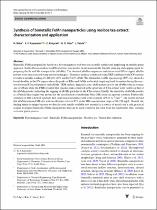| dc.contributor.author | Böke, Nuran | |
| dc.contributor.author | Kapiamba, Kashala Fabrice | |
| dc.contributor.author | Kimpiab, Elyse | |
| dc.date.accessioned | 2023-03-29T09:29:52Z | |
| dc.date.available | 2023-03-29T09:29:52Z | |
| dc.date.issued | 2023 | |
| dc.identifier.citation | Böke, N. et al. (2023). Synthesis of bimetallic FeMn nanoparticles using rooibos tea extract: characterization and application. International Journal of Environmental Science and Technology. https://doi.org/10.1007/s13762-023-04792-1 | en_US |
| dc.identifier.issn | 1735-2630 | |
| dc.identifier.uri | https://doi.org/10.1007/s13762-023-04792-1 | |
| dc.identifier.uri | http://hdl.handle.net/10566/8691 | |
| dc.description.abstract | Bimetallic FeMn nanoparticles based on a ferromanganese wad were successfully synthesized employing an entirely green
approach. South African rooibos tea (RTea) extract was used as an environmentally friendly reducing and capping agent for
preparing the Fe and Mn nanoparticles (nFeMn). The obtained nFeMn suspension and freeze-dried RTea capped nFeMn
powder were characterized using several techniques. Elemental analysis conducted using XRF combined with ICP analysis
revealed a metallic loading of 1.08 wt% of Fe and 0.25 wt% of Mn. The ultraviolet–visible spectroscopy (UV–vis) showed a
broad shoulder in the UV region where the peaks of RTea and FeMn are located, implying bond formation during the reaction
between RTea polyphenols and nFeMn. TEM analysis depicted a core–shell architecture for the nFeMn with an average
size of 20 nm while the FTIR revealed that specific peaks observed in the spectrum of RTea extract were visible on that of
the nFeMn powder, indicating the capping of nFeMn particles by the RTea extract. Finally, the reactivity of nFeMn powder
as a Fenton-like reagent was probed for the decoloration of methylene blue (MB) from an aqueous solution. Fenton-like
oxidation of MB followed a pseudo-first-order reaction kinetics with a rate constant of 0.23 A−
1 min−
1. The results showed
that nFeMn removed MB dye with an efficiency of over 95% in the MB concentration range of 50–250 mg/L. Overall, the
finding herein is unique because we directly used readily available raw material as a source of metals and a safe, practical
reagent to prepare bimetallic FeMn nanoparticles that can be used to remove the color from dye wastewater, thus, creating
a circular green process. | en_US |
| dc.language.iso | en | en_US |
| dc.publisher | Springer | en_US |
| dc.subject | Ferromanganese wad | en_US |
| dc.subject | Rooibos tea | en_US |
| dc.subject | Fenton-like oxidation | en_US |
| dc.subject | South Africa | en_US |
| dc.subject | Methylene blue | en_US |
| dc.title | Synthesis of bimetallic FeMn nanoparticles using rooibos tea extract: characterization and application | en_US |
| dc.type | Article | en_US |

